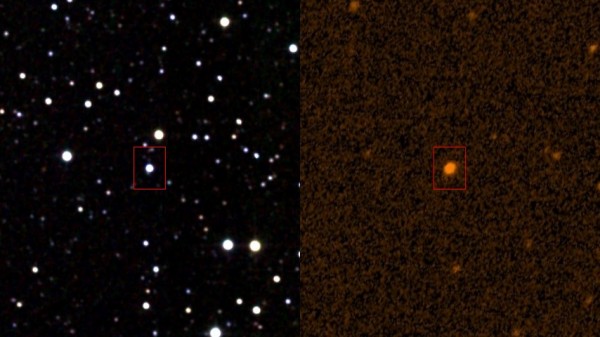By Ana Verayo, | December 27, 2016

Tabby's Star in infrared (2MASS survey) and ultraviolet (GALEX). (Department of Physics University of Illinois)
A dimming distant star known as KIC 846852 has remained an enigma for scientists for more than a year. Astronomers have suggested in the past that this highly unusual star is surrounded by comets or asteroids attacking it or an "alien megastructure" might be blocking this star's light. However, there is a new theory that can potentially explain this mysterious star.
Like Us on Facebook
Thanks to NASA's Kepler Space Telescope, distant stars can now be detected by monitoring the dips in brightness that would result in random intervals and varying degrees of luminosity.
Also known as Tabby's star, this bizarre, irregular dimming star is located in the constellation Cygnus some 1,276 light years away from Earth.
KIC 846852 also shows instances that 20 percent of its starlight is being blocked in erratic dimming patterns, similar to how Jupiter would block our sun. The question is, what cosmic object can be blocking this star?
Astronomers have proposed multiple theories such as a swarm of comets or a planetary disk of dust and cosmic gasses passing by this star, but both theories remain inconclusive.
In this new study, a team from the University of Illinois have proposed a possible theory regarding the star's smaller dips of light, which are consistent with an avalanche model, when smaller dips of light can accumulate into massive dips of brightness seen from Earth.
According to the author of the study, Mohammed Sheikh from the University of Illinois, when this light curve drops below its threshold, it considered the beginning of an avalanche event.
These new findings suggest that this dimming event can be an intrinsic quality of the star, meaning that this bizarre activity can indicate a transitional phase of the star.
According to the author of the study, Richard Weaver of the University of Illinois, more data is needed to identify the type of transition that Tabby's star is going through. To date, there is no definitive answer and more observations are required to gain a better understanding of this phenomenon.
This new study was published in the journal, Physical Review Letters.
-
Use of Coronavirus Pandemic Drones Raises Privacy Concerns: Drones Spread Fear, Local Officials Say

-
Coronavirus Hampers The Delivery Of Lockheed Martin F-35 Stealth Fighters For 2020

-
Instagram Speeds Up Plans to Add Account Memorialization Feature Due to COVID-19 Deaths

-
NASA: Perseverance Plans to Bring 'Mars Rock' to Earth in 2031

-
600 Dead And 3,000 In The Hospital as Iranians Believed Drinking High-Concentrations of Alcohol Can Cure The Coronavirus

-
600 Dead And 3,000 In The Hospital as Iranians Believed Drinking High-Concentrations of Alcohol Can Cure The Coronavirus

-
COVID-19: Doctors, Nurses Use Virtual Reality to Learn New Skills in Treating Coronavirus Patients







